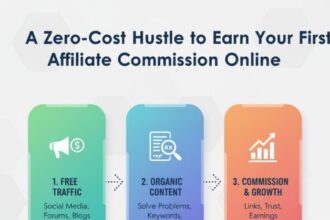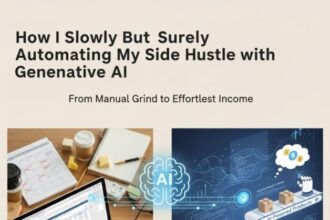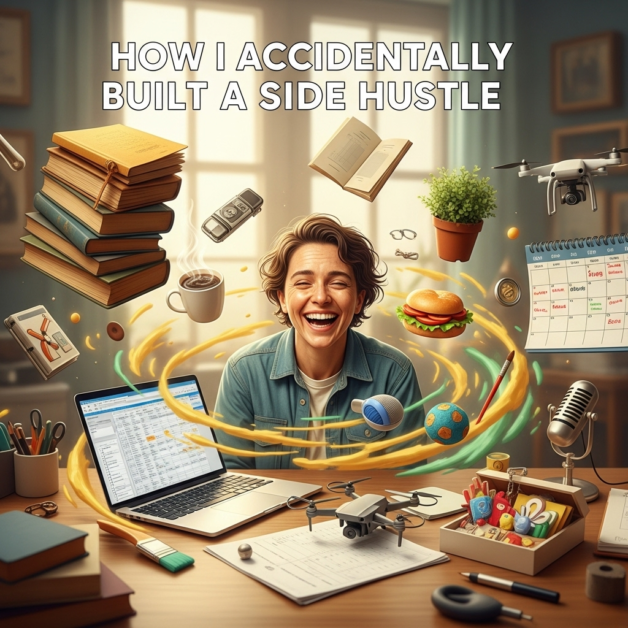My Brain Felt Like Scrambled Eggs: How I Started Learning AI with Free Resources for Beginners
My eyes felt like they had sand in them. I was on my fourth hour of staring at a screen filled with what I can only describe as cryptic poetry written by a robot. There were brackets and colons and weird indented lines of import pandas as pd. My coffee had gone cold, my posture was atrocious, and my brain had the distinct consistency of overcooked scrambled eggs.
This whole grand adventure, this quest I’d set for myself of learning AI with free resources for beginners, was starting to feel less like a noble pursuit and more like a very effective, very specific form of self-punishment.
It had all seemed like such a good idea a few weeks ago.
I mean, you can’t get away from it, can you? AI. It’s this constant, low-level hum in the background of life that’s getting louder every single day. It’s recommending songs, finishing our sentences, creating bizarre images of frogs in historical paintings. It felt like this huge, culture-shifting thing was happening, and I was just standing there, watching it on the news like it was happening to someone else.
I didn’t want to be a bystander anymore. I just wanted to peek behind the curtain. Just a little.
So I did what we all do. I opened my laptop, took a deep breath, and typed “How to learn AI?” into the search bar.
And the internet promptly exploded in my face.
It wasn’t just information; it was a tidal wave of jargon. A firehose of intimidating acronyms. I was instantly buried under “neural networks,” “gradient descent,” “natural language processing,” and something called “tensor calculus,” which sounds less like a real thing and more like a spell from a fantasy novel.
Every article I clicked, every video I watched, seemed to be made for people who were already card-carrying members of the secret genius club. It felt like trying to learn how to bake by reading a textbook on molecular gastronomy. I felt small. I felt profoundly dumb. And I felt like I was already hopelessly behind in a race I didn’t even know I was supposed to be running.
This post is for anyone who is feeling that way right now. The person with a dozen browser tabs open, each one making them feel more confused than the last. Because I was you. Just a few short months ago, that was me. And I’m here to report back from the other side of the jungle to tell you that there is a path through. It’s winding, it’s messy, and you’ll probably trip a lot.
But it’s there. And it doesn’t have to cost you a thing.
My First Steps Into the Weird World of AI
After that initial, ego-crushing encounter with Google, my strategy, if you can call it that, was pure chaos. I was a digital hoarder. I signed up for every newsletter. I bookmarked fifty articles that all had titles like “The Ultimate Guide to AI.” I subscribed to a dozen YouTube channels, most of which featured guys talking incredibly fast in front of a whiteboard covered in terrifying equations.
My thinking was, if I just immerse myself in this stuff, eventually it’ll start to make sense through sheer osmosis. (Spoiler alert: that is not how learning works.)
My main focus at first was on finding online AI courses. That seemed logical, right? Find a nice, structured path and follow it. But the word “beginner” in the course titles turned out to be a very loose suggestion. One course wanted me to install three different command-line tools before lesson one even started. Another began its “gentle introduction” by casually mentioning linear algebra, at which point I felt a cold dread creep up my spine and immediately closed the window.
It was a total mess. I was spinning my wheels and getting absolutely nowhere.
Drowning in Jargon Soup
The biggest, baddest gatekeeper, without a doubt, was the language. It felt like trying to join a conversation where everyone else was speaking a secret code. You’d watch a video to understand what a “neural network” was, and the explanation would casually drop terms like “nodes,” “weights,” “biases,” and “activation functions.” So you’d have to pause that video to go look up what those things meant.
It was an endless, exhausting nesting doll of confusion.
I swear, I spent one entire evening just trying to untangle the difference between “AI,” “Machine Learning,” and “Deep Learning.” As far as I can tell now, it’s basically a “thing-within-a-thing” situation.
AI is the giant, all-encompassing umbrella. It’s the whole idea of making machines smart, going all the way back to old-school chess programs. It’s the entire universe of the concept.
Then, inside that universe, you have Machine Learning. This is the big deal right now. Instead of programming a computer with explicit rules for every situation, you just show it a zillion examples and let it figure out the patterns on its own. It learns. This is the core idea behind machine learning basics.
And then, inside that, you have Deep Learning. That’s the really high-octane stuff. It uses those “neural networks” with many, many layers to do the really wild things we see now, like creating art or having a conversation.
Just getting that simple hierarchy straight in my head felt like I’d decoded an ancient secret. It was the first time I felt like I had a map, even if it was a crumpled, hand-drawn one.
My First “Success” Was Actually a Failure
Feeling slightly more confident, I decided it was time to actually do something. I found a tutorial for what seemed like the “Hello, World!” of machine learning projects: predicting iris flower species from a famous dataset. It sounded so quaint and harmless.
It was not.
First, I had to figure out how to get something called a “Jupyter Notebook” running without my computer having a meltdown. Then came the barrage of installations: Pandas, NumPy, scikit-learn. I spent more time troubleshooting cryptic error messages than I did learning anything about AI.
Eventually, through sheer stubbornness, I got it all working. I dutifully copied and pasted the code from the tutorial, hit the “run” button, and watched as a little line of text popped out: “Model accuracy: 97%.”
I had done it. I was an AI genius.
Except I felt absolutely nothing. I had no idea why the code worked. I didn’t understand what any of it meant. I could have been typing in spells from a wizard’s book for all I knew. I hadn’t learned a single concept. I’d only proven that I was capable of transcription. It was the most hollow victory imaginable, and it made me realize I was going about this all wrong.
Turns Out, a Lot of People Are Wrong About AI
After the great flower fiasco of ’25, I took a breather. I vented to a few friends about my struggles, and it opened my eyes to something: almost everyone, myself included, is walking around with some seriously strange and intimidating ideas about what AI is and who gets to play with it.
It’s surrounded by this aura of impenetrable genius, like it’s forged in a secret volcano by math elves. But a lot of that is just a big misunderstanding.
So let’s just tear down a few of the myths that almost made me give up entirely.
The Big One: “You Have to Be a Math Genius.”
This is the myth that slays more aspiring learners than any other. The second someone brings up “calculus” or “linear algebra,” a little panic button goes off in our brains. I know it did for me. My high school math trauma is real and valid, thank you very much.
And look, are the people at the absolute cutting edge, the ones inventing entirely new AI architectures, masters of mathematics? Yes. Absolutely. They are wizards of the highest order.
But to use AI? To apply it and build interesting things with it? You really, really don’t.
Here’s the wonderful secret: brilliant people have already done all the hard math and packaged it up into free, accessible tools. It’s like driving a car. I have no idea how internal combustion actually works—the physics of it, the thermodynamics—but I can drive to the store just fine. Someone else already built the engine.
Learning to apply AI today is far more about learning the rules of the road than it is about becoming a mechanical engineer. You don’t have to build the engine from scratch.
The Coder Myth: “You Need to Be a Programming Whiz.”
This goes hand-in-hand with the math myth. We picture some hoodie-clad savant who has been fluent in seven programming languages since they were in middle school. I came into this with a grasp of programming that was shaky at best.
You do need to learn to code. Let’s be clear about that. But you don’t need to be a software developer who dreams in code.
The language of AI is overwhelmingly Python. And the big push to learn Python for AI exists for a very good reason: it’s famous for being readable and relatively straightforward. You don’t need to learn all of it. You just need to learn a functional subset of it—enough to manipulate data and plug it into the libraries that other people built. It’s a much more manageable task than it sounds. Your goal is to be a competent tool user, not a master craftsperson.
The Ivory Tower Myth: “It’s Only for Elite Tech Companies.”
For a long time, this was basically true. You needed supercomputers the size of a refrigerator and a team of Ph.D.s. Not anymore.
This is maybe the most radical shift. Companies like Google and Meta have given their core AI frameworks—the very tools their own world-class teams use—to the public. For free. It’s called open-source, and it’s the great equalizer. This movement is often called “AI for everyone,” and it’s not just a feel-good slogan. It’s a real, tangible thing. It means that a curious person in their bedroom has access to the same fundamental firepower as a researcher at a multi-billion dollar corporation. As major publications like The Economist have pointed out, this widespread access is what’s fueling the current creative explosion in the field.
You don’t need a keycard to a fancy lab anymore. You just need a laptop and an internet connection.
The Straight-Line Myth: “Learning Is a Step-by-Step Process.”
This was the lie that trapped me the longest. My brain is conditioned by years of traditional schooling to believe that learning works like a ladder. You start on Rung 1, then you go to Rung 2, and so on.
Learning AI is not a ladder. It’s more like a sprawling, messy spiderweb.
You’ll start on one thread, which will lead you to another. You’ll watch a video, and it’ll raise a question, so you’ll jump to another thread to answer that question. You’ll get stuck, try to build something, fail, and in the process of figuring out why you failed, you’ll accidentally learn three new things you didn’t even know you were supposed to be learning.
You have to learn to be comfortable with being confused. You have to embrace the feeling of not knowing. The moment I gave up on finding the “perfect” curriculum and just let myself get wonderfully, chaotically lost, was the moment I actually started finding my way.
The One Simple Idea That Finally Made AI Click
I spent weeks in what I now call “tutorial purgatory.” I was dutifully following along with videos and articles, but nothing was sticking. I was memorizing recipes without ever learning how to cook. I knew the names of things, but I had no real intuition, no feel for any of it.
The breakthrough, the moment that made the entire landscape snap into focus, wasn’t a complex equation or a clever line of code. It was a laughably simple realization.
AI isn’t about the algorithm. It’s about the data.
That’s it. That was the whole thing.
It’s All About the Ingredients, Not the Oven
I had been completely obsessed with the “model”—the fancy, complicated algorithm that does the learning. I thought that was where the magic lived. It’s not. The algorithm is just the oven. A very important, very powerful oven, but an oven nonetheless.
The real magic, the thing that determines everything, is the ingredients you put in it. The data.
Think about baking a cake. You can have a $10,000 state-of-the-art convection oven. But if your ingredients are rotten eggs, spoiled milk, and gravel instead of flour, you are going to get a disgusting, inedible brick. The world’s best oven cannot save garbage ingredients.
On the other hand, if you have fresh, high-quality ingredients that you’ve carefully prepared, you can bake a pretty darn good cake even in a modest, cheap oven.
This flipped a switch in my brain. I stopped worrying about finding the “best” or “newest” algorithm. Instead, I got obsessed with the ingredients. I started to focus on the data science fundamentals.
From Code Monkey to Crime Scene Investigator
This shift in perspective was liberating. It turned me from a frustrated code monkey, blindly typing commands, into a curious detective. The dataset was my crime scene, and the model was my prime suspect. My job was to investigate.
I started spending the vast majority of my time just getting to know the data. I’d make simple charts. What’s the average of this column? What’s the weirdest value in that one? Are there huge chunks of information missing? Are there patterns I can see with my own two eyes before I even ask a machine to look?
This process is called Exploratory Data Analysis (EDA), and it felt a million times more creative and intuitive than what I was doing before. I was asking my own questions. I was hunting for clues. If you’re struggling to get started, I wrote a bit about [great places to find interesting datasets] which might help you find your first “crime scene.”
And the craziest part? After I spent a few hours just exploring the data, I had a much better sense of what to do next. The data itself started telling me what it needed. It was like the ingredients were whispering the recipe to me. This “data-first” approach grounded everything in reality and took AI from being this scary, abstract monster and turned it into a fascinating puzzle. And I love puzzles.
My No-Nonsense Guide to Actually Learning AI
So, after all the stumbling and the false starts and the small, exhilarating victories, I’ve managed to patch together a learning system that actually works for me. This isn’t the official, university-approved curriculum. It’s my personal, cobbled-together, “this-is-what-actually-worked” guide from the trenches.
If you’re feeling stuck, maybe my messy map can help you find your own way.
Here’s my unofficial playbook.
Step 1: First, Just Breathe. Get the Bare Minimum.
Before you can do anything cool, you need a tiny, stable foundation. Not a giant concrete slab, just a few sturdy bricks. For AI, that’s a tiny bit of Python and a high-level grasp of the concepts.
For Learning Python: For the love of all that is holy, do not try to read a 600-page textbook. You will give up. I found interactive platforms to be the only thing that worked. My absolute champion is Kaggle. It’s a site for data science competitions, but its “Learn” section is pure gold. Their free micro-courses on “Python” and “Pandas” are a godsend. They are short, they are hands-on, and you write code in your browser from minute one. No setup, no fuss.
For the Big Ideas: Don’t start with academic papers. Start on YouTube. Seriously. A channel like 3Blue1Brown has these beautiful, animated videos that explain the core ideas of neural networks in a way that is just… breathtakingly intuitive. For more general context, listening to the Lex Fridman Podcast is like being a fly on the wall for conversations with the smartest AI people on the planet. You won’t get it all, but you’ll start to absorb the vocabulary and the rhythm of the field.
Step 2: The “Get Your Hands Dirty” Mandate
This is the most critical step. You have to stop consuming and start creating. You can watch videos of people swimming all day long, but you won’t learn until you get your hair wet. You have to find some simple AI projects for beginners and just dive in.
Find Your Sandbox: Once again, I point you to Kaggle. It is the ultimate sandbox. It has thousands of datasets on every topic imaginable, from spotting pneumonia in X-rays to analyzing Taylor Swift lyrics. Crucially, it has “Notebooks”—those coding environments I mentioned—all set up for you, with the data ready to go.
Embrace the “Fork and Fiddle”: This was my secret weapon. Find a project someone else has already completed. Kaggle is full of them. Find one that looks interesting and hit the “Copy and Edit” button (a feature they call “forking”). This creates your own personal copy of their entire project. Then, just break it. Fiddle with it. Change a number and see what happens. Try to make a different graph. Add a comment explaining what you think a line of code does. This process of tinkering with something that already works is a thousand times more effective than staring at a blank screen.
Step 3: Find Your Lifeline (The Community)
You will get stuck. You will hit a wall. You will see an error message that will make you question all your life choices. This is not a possibility; it is a certainty. When this happens, a good AI community is the only thing that will save your sanity.
Where to Look: The discussion forums on Kaggle are fantastic. But for real-time help, communities on Reddit (like the r/MachineLearning subreddit) or specific Discord servers are amazing. You can post your question, and there’s a good chance a kind stranger from across the world will help you out.
How to Ask for Help: This is a skill. Don’t just post “it’s broken.” Explain what you hoped to achieve, show your code, and paste the full, ugly error message. The more clues you give the detectives, the faster they can solve the case. Never be afraid to sound like a newbie. Every single person you’re asking for help was a newbie once. Exploring official documentation, like the fantastic guides for the scikit-learn library, is another pro move. Going straight to the source often gives you the clearest answer. We actually have a post on [how to get unstuck when coding] that dives deeper into this very art.
This simple loop—learn a little, build a little, ask for help—is the whole engine. It’s not glamorous, but it’s the only thing that truly works.
So, Where Does That Leave Me?
My brain, on any given day, is still about 30% scrambled eggs. I am not an AI expert. I am not a “data scientist.” I’m just a deeply curious person who was too stubborn to quit.
But something inside me has fundamentally shifted.
I no longer look at the term “AI” and feel a wave of dread and inadequacy. I feel a spark of curiosity. I see it as a set of tools, a new box of crayons to draw with. They’re weird, powerful, and often frustrating crayons, but they’re mine to use.
I can look at a spreadsheet full of numbers now and not see a boring chore, but a story waiting to be told. I can read a headline about a new AI model and have a fighting chance of understanding what it actually means. The world feels a little less like magic and a little more like a fascinating, solvable puzzle.
The journey of learning AI with free resources for beginners is about so much more than acquiring a new skill for your resume. It’s about demystifying the single most important technology of our time. It’s about reclaiming a sense of agency in a world that’s changing at lightning speed.
And that feeling, that’s worth all the cold coffee and scrambled-egg brains in the world.
So if you’re out there, staring at that same mountain I was, just take one small step. Pick one question you’re curious about and chase that thread.
What’s the first thing you want to know?








































